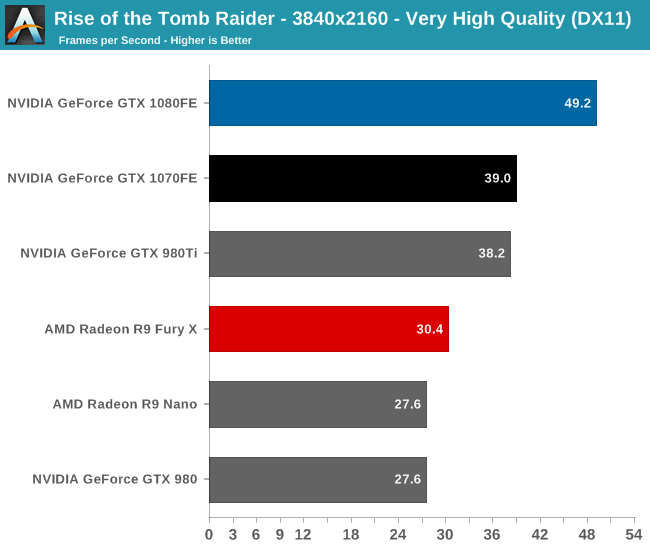The NVIDIA GeForce GTX 1080 & GTX 1070 Founders Editions Review: Kicking Off the FinFET Generation
by Ryan Smith on July 20, 2016 8:45 AM ESTRise of the Tomb Raider
Starting things off in our benchmark suite is the built-in benchmark for Rise of the Tomb Raider, the latest iteration in the long-running action-adventure gaming series. One of the unique aspects of this benchmark is that it’s actually the average of 4 sub-benchmarks that fly through different environments, which keeps the benchmark from being too weighted towards a GPU’s performance characteristics under any one scene.



To kick things off then, while I picked the benchmark order before collecting the performance results, it’s neat that Rise of the Tomb Raider ends up being a fairly consistent representation of how the various video cards compare to each other. The end result, as you might expect, puts the GTX 1080 and GTX 1070 solidly in the lead. And truthfully there’s no reason for it to be anything but this; NVIDIA does not face any competition from AMD at the high-end at this point, so the two GP104 cards are going to be unrivaled. It’s not a question of who wins, but by how much.
Overall we find the GTX 1080 ahead of its predecessor, the GTX 980, by anywhere between 60% and 78%, with the lead increasing with the resolution. The GTX 1070’s lead isn’t quite as significant though, ranging from 53% to 60#. This is consistent with the fact that the GTX 1070 is specified to trail the GTX 1080 by more than we saw with the 980/970 in 2014, which means that in general the GTX 1070 won’t see quite as much uplift.
What we do get however is confirmation that the GTX 1070FE is a GTX 980 Ti and more. The performance of what was NVIDIA’s $650 flagship can now be had in a card that costs $450, and with any luck will get cheaper still as supplies improve. For 1440p gamers this should hit a good spot in terms of performance.
Otherwise when it comes to 4K gaming, NVIDIA has made a lot of progress thanks to GTX 1080, but even their latest and greatest card isn’t quite going to crack 60fps here. We haven’t yet escaped having to made quality tradeoffs for 4K at this time, and it’s likely that future games will drive that point home even more.
Finally, 1080p is admittedly here largely for the sake of including much older cards like the GTX 680, to show what kind of progress NVIDIA has made since their first 28nm high-end card. The result? A 4.25x performance increase over the GTX 680.










200 Comments
View All Comments
Ninhalem - Wednesday, July 20, 2016 - link
There's 32 freaking pages in this review. Maybe people have other jobs instead of writing all day long. Did you ever think of that?I'll take quality and a long publishing time over crap and rushing out the door.
Stuka87 - Wednesday, July 20, 2016 - link
Thanks for the extremely in depth review Ryan!cknobman - Wednesday, July 20, 2016 - link
I cannot help feel just a bit underwhelmed.Of course these Nvidia cards kick some major butt in games that have always favored Nvidia but I noticed that in games not specifically coded to take advantage of Nvidia and furthermore games with DX12 that these cards performance advantage is minimal at best vs an old Fury X with half the video RAM.
Then when you take into account Vulcan API and newer DX12 games (which can be found elsewhere) you see that the prices for these cards is a tad ridiculous and the performance advantage starts to melt away.
I am waiting for AMD to release their next "big gun" before I make a purchase decision.
I'm rocking a 4k monitor right now and 60fps at that resolution is my target.
nathanddrews - Wednesday, July 20, 2016 - link
1080 is close to being that 4K60 card, but can't quite cut it. I'm waiting for "Big Vega" vs 1080Ti before dropping any money.lefty2 - Wednesday, July 20, 2016 - link
Great review - one of the few that highlights the fact the Pascal async compute is only half as good as AMD's version. Async compute is a key feature for increasing performance in DX12 and Vulkan and that's going to allow the RX 480 to perform well against the GTX 1060Daniel Egger - Wednesday, July 20, 2016 - link
"... why the memory controller organization of GP104 is 8x32b instead of 4x64b like GM204"Sounds like it's the other way around.
Ryan Smith - Wednesday, July 20, 2016 - link
No, that's correct. 8 32bit wide controllers rather than 4 64bit wide controllers.http://images.anandtech.com/doci/10325/GeForce_GTX...
http://images.anandtech.com/doci/8526/GeForce_GTX_...
DominionSeraph - Wednesday, July 20, 2016 - link
>It has taken about 2 years longer than we’d normally see... for a review of a flagship card to come out
sgeocla - Wednesday, July 20, 2016 - link
The old Maxwell was so optimized it was always full and didn't even need Async Compute. The new Pascal is so much more optimized that it even has time to create the "holes" in execution (not counting the ones in your pocket) that were "missing" in the old architecture to be able to benefit for Async Compute. Expect Volta to create even more holes (with hardware support) for Async Compute to fill.tipoo - Wednesday, July 20, 2016 - link
That's demonstrably untrue.http://www.futuremark.com/pressreleases/a-closer-l...
Plenty of holes that could have been filled in Maxwell.